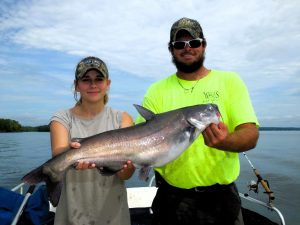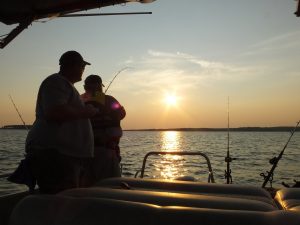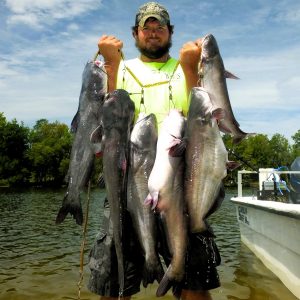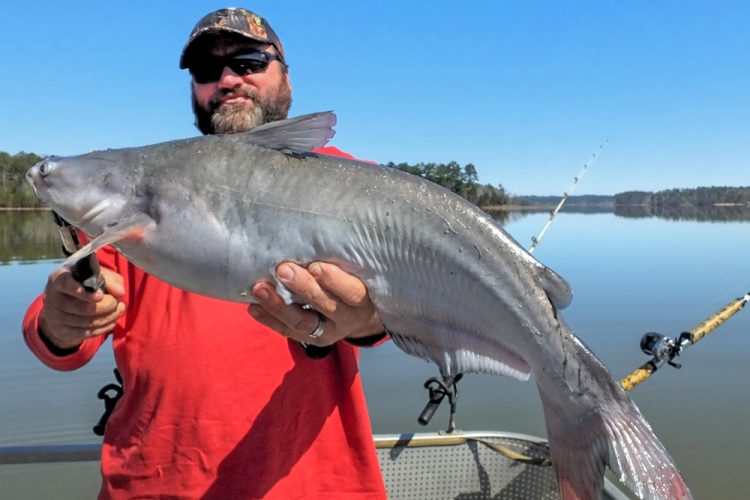Guide Chris Simpson said the blue, flathead and channel catfish all thrive at Clarks Hill Lake.
South Carolina Triple Threat for Catfish
Story and photos by Terry Madewell
If you’re looking for an excellent catfishing destination with plenty of diversity and the potential to yield an abundance of catfish action, cut a swath across the Palmetto State of South Carolina and discover a wealth of whiskered opportunities. Anglers can fish three completely different types of lakes for catfish, with all three of the big three species of catfishing—blues, flatheads and channel cats—in play. It’s a genuine triple threat, with the common denominator of excellent catfishing in quality, quantity and species diversity.
The South Carolina fishing license is the only one you need to fish in all three lakes.
Begin the tour along the South Carolina-Georgia border on Clarks Hill Lake, a massive Corps of Engineers reservoir teeming with big blues, fat flatheads and scads of chunky channel catfish. Next is the mid-state target, Lake Monticello, a deep, clear, pump-back lake known for producing huge blues and scads of the smaller channel and blue catfish. Then wander over to Wateree Lake on the Catawba River chain for excellent action on ‘teener blues, the occasional big blue and plenty of channel catfish.
Clarks Hill Lake
Encompassing 71,000 surface acres of water and 400 miles of shoreline, Clarks Hill Lake is a big water, and big fish, catfish lake. The lake is the last impoundment on the Corps of Engineers chain of lakes on the Savannah River, and a reciprocal fishing license agreement exists between the two states.

Capt. Chris Simpson (864-992-2352) has been a fishing guide on many lakes in South Carolina and has settled on this lake as his home because it offers everything he wants regarding catfishing. He said this Savannah River lake consistently produces trophy blue and flathead catfish.
“I target trophy blues and flatheads, and the key for either is targeting specific spots near the main Savannah River channel during warm weather,” he said. “I like long points dropping into deep water, humps adjacent to the Savannah River channel and deep holes. Some major feeder tributaries have enough water depth to hold quality catfish during the summer. Rocky areas are great for flatheads.”
Clarks Hill ranks near the top among channel catfish spots in the Palmetto State, and Simpson offers trips for anglers who want to target this species.
“We’ll use stinkbaits and smaller cut-bait and hit multiple humps and ledges, and it’s common to catch a lot of fish by day or night,” he said.
Anglers can stay overnight in nearby Aiken, SC. For detailed information on lodging, restaurants and other opportunities, visit Discover Aiken County.
Lake Monticello
Lake Monticello, covers 7,000 acres just 45 minutes northeast of downtown Columbia, South Carolina. This deep, clear-water fishery has earned a reputation for trophy blue catfishing that often peaks in cold weather. But summer action is also excellent for big fish, plus eating-size blues and channel cats.

William Attaway of Pomeria, South Carolina, guides at Lake Monticello and Lake Murray. He said he’d focus on deep water by day and suspended fish on flats and off points at night.
“Lake Monticello has water pumped into and out of it, and that creates enough water turnover that deep-water fishing is good during the summer,” he said.
Attaway (Slick Willies Guide Service; 803-924-0857) will target big blues daily in 30 to 60 feet of water.
“I use electronics to scan the points and humps, and the lake does produce quality fish during the summer,” he said.
Attaway said he downsizes rigs and baits to target numbers of fish.
“Lake Monticello has an abundant population of blues in the 1- to 10-pound class and plenty of channel catfish in great eating sizes,” he said. “Fishermen can fill a cooler of good-sized fish on most days in the summer with a bit of moving around. And we always have the chance to hook huge blues in this lake.”
Attaway said he’ll use cut white perch, bream and shad during the summer as preferred baits.
Lake Monticello is in rural Fairfield County. The Olde English Tourism District is the ideal source for nearby accommodations, restaurants and non-fishing activities.
Lake Wateree

The catfish bite at Lake Wateree, the last impoundment on the Catawba River, is consistently good throughout summer, making this a good time to target numbers of quality catfish. Fishing (catfish and striper) guide Justin Whiteside said anchored setups and driftfishing provide good opportunities to hook big cats.
“I prefer to anchor on specific targets to begin the day, and most targets are not in deep water,” he said. “During the summer, Lake Wateree has a thermocline at around 20 to 22 feet deep, and most of my fishing will be at that depth and often considerably shallower.”
Depending on the productivity of the anchored fishing bite, Whiteside may driftfish later in the morning and the rest of the day. He said the entire lake is productive, but his favored area ranges from Lake Wateree State Park to the dam on this 13,025-acre lake with 216 miles of shoreline. Whiteside focuses on the main river channel and several large creeks when hunting catfish in warm weather.
Whiteside (803-417-0070; Whiteside’s Whiskers on Facebook) said clients often hook big blue catfish in water less than 10 feet deep, even during mid-day. He’ll cast rigs into multiple depths from his anchored setup until he locks in on a solid pattern for the day. When forage is scattered, he will driftfish the humps and ledges.
Whiteside employs various baits, including gizzard and threadfin shad, white perch and bream.
The Olde English Tourism District is the ideal source for accommodations, restaurants and non-fishing activities around the lake.
(Terry Madewell of Ridgeway, South Carolina has been an outdoor communicator for nearly 50 years. He holds a degree in Wildlife and Fisheries Management and has a long career as a professional wildlife biologist/natural resources manager. He’s passionate about sharing outdoor adventures with others.



